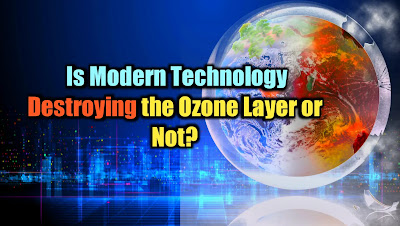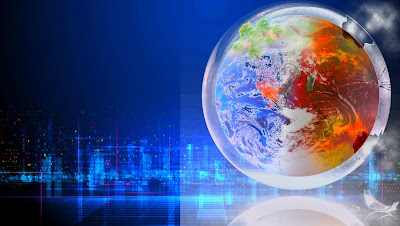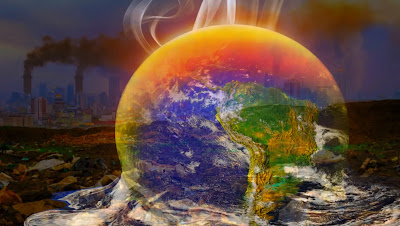Is Modern Technology Destroying the Ozone Layer or Not?
The ozone layer protects the earth from harmful ultraviolet radiation. When this protective shield is disrupted, it's quite possible that modern technology is to blame. How does modern technology damage the ozone layer? What are the signs that indicate that your business is damaging the ozone layer? How can you help reverse damage that has already been done? Is there a link between CFCs and global warming? Here are some questions you might have about this issue, and why you should care about them.
Blog List:
1. How does modern technology damage the ozone layer?
2. How do CFCs affect the environment?
3. What are the signs that your business is damaging the ozone layer?
4. What can you do to help reverse damage that has already been done?
5. Is there a link between CFCs and global warming?
{tocify} $title={Table of Contents}
1. How does modern technology damage the ozone layer?
Most ozone layer damage is due to chlorofluorocarbons (CFCs), which are compounds used as refrigerants, solvents, and foam-blowing agents. Inhalation of CFCs contributes to the destruction of the ozone layer.Ozone Layer Loss Is Part of a Human Lifespan.
Ozone depletion is a part of a continuum of aging processes in the environment. Ozone layer degradation can be a factor in premature mortality. Most studies that have looked at air quality in cities located near CFCs show increased morbidity due to poor air quality, and links between those living near CFC-rich locations and premature mortality.
Orangerweg offers an interesting perspective on premature mortality:
“Cancer risk is becoming a bigger public health problem, partly because those affected tend to live longer. Exposed individuals continue to build up an oxidative stress in the body and in the environment that leads to cancer development. There is now substantial evidence linking bad air quality and health problems amongst those living near CFC districts.”
In other words, just because air quality near a CFC production plant is bad and unhealthy doesn’t mean it’s all the CFCs’ fault.
What Can I Do About Ozone Layer Depletion?
Protect yourself by following proper maintenance and cleaning practices. Neatness and regular cleaning can save you money and preserve the life of the ozone layer. Make sure you monitor your own location for increased levels of carbon monoxide, particulate matter, and air pollution.
What Are the Signs That Your Business Is Destroying the Ozone Layer?
When companies use large amounts of CFCs, they are breaking the ozone layer. When this happens in the industrial sector, it is called industrial pollution. It may be due to your location; however, one thing is for sure: it is the responsibility of every business to actively work to reduce or eliminate pollution wherever it exists.
2. How do CFCs affect the environment?
CFCs are a family of chemicals widely used as refrigerants, propellants, solvents, foam-blowing agents, and cleaning agents. They contain chlorine, fluorine, and carbon. Most CFCs are now banned because they contribute to ozone depletion by allowing UV radiation to pass through the stratosphere and reach the Earth's surface. Since CFCs were banned, the EPAs Air Quality Index (AQI) has decreased because of less sunlight penetrating the stratosphere. The AQI for ambient air in Washington state was recently listed at 86. This is not good.
How Does Ozone Depletion Happen?
Chlorine and fluorine in air trap molecules of oxygen in the upper atmosphere, the “lower stratosphere,” and the formation of ozone. Fluorine and chloroform are reactive, absorbing other elements and molecules of oxygen, and with them oxygen, oxygen damage starts to occur. Soon it is undetectable to the naked eye. Even the infrared detectors on airplanes can’t pick up oxygen degradation.
What Pollutant Causes Ozone Depletion?
As already mentioned, ozone loss happens in certain parts of the atmosphere, and is a much bigger problem from synthetic sources than climate change.
About 80% of artificial input in the atmosphere is chlorinated and 100% of that is from industries that burn fossil fuels.
Industry Inputs That Cause Ozone Depletion
Industries like power plants, refineries, petrochemical plants, tanneries, metal smelting facilities, beef and pork producers, cement and asphalt plants, and factories that produce polychlorinated biphenyls (PCBs) and chlorinated dichloroethylene (PCDE) are the biggest contributors of the damage to the oxygen layer. In fact, each year, humans dump about 14 billion tons of pollutants into the air.
Ozone Layer Symptoms
When the air gets to anywhere near 100 degrees, it’s very dangerous. The color of the sky changes; you begin to feel nauseous and dizzy; your headaches become debilitating, and you start to experience shortness of breath, as well as chest pain and difficulty concentrating.
Typical symptoms of Ozone Depletion can include shortness of breath, cough, fatigue, shortness of breath, headaches, trouble concentrating, and chest pain.
Read More Details: 5 Great Student Hackathon Projects On Space Technology: Studying Outer Space
3. What are the signs that your business is damaging the ozone layer?
The Earth's ozone layer protects us from the sun's harmful ultraviolet radiation. It's made up of ozone gas molecules in the stratosphere, which are constantly moving around. Ozone depletion happens when the ozone layer becomes damaged, thin, or disappears. The main cause of ozone depletion is human activities.
Radioactive fallout
CFCs are chemicals that naturally occur in the environment. These chemicals bind to CFCs in the environment, forming something called an oxidant. Ozone in the stratosphere is negatively impacted by the oxidants, which means it eventually mixes with the lower stratosphere. Ozone then begins to deposit on the surface of the earth. These clouds of pollutants are known as stratospheric clouds, and they extend from about 30 to 100 miles up into the stratosphere.
Ozone layer damage
When an oxidant damages the ozone layer, it removes oxygen from the stratosphere, exposing it to the air down below. In turn, the stratosphere's surface has more oxygen, and it becomes warmer, which causes more sunlight to enter it. This overwintered and re-warmed layer results in more sunlight reaching the ground, which warms it up even more. It becomes an endless cycle—and if the process continues long enough, we could end up with a layer of ozone (that lies above the ground) that is negatively affected by pollution.
What is Ozone Layer Degeneration and What are the Signs This Might Be Happening?
Ozone layer depletion tends to happen when more sunlight comes in than is needed. Going down into the stratosphere, you see sunlight that would normally be avoided due to the harmful effects of ultraviolet light. This includes many types of sunlight, but also some sunlight from the ground surface. If more sunlight from the ground is seen than is needed, ozone is likely to be depleted in the stratosphere.
If you begin to see or feel changes in levels of ozone within a short time after starting your campaigning against pollution, then your contacts may be to blame.
4. What can you do to help reverse damage that has already been done?
There are things you can do to help reverse some of the damage that has already been done. If you’re out of shape, then start exercising. It sounds simple, but it’s an important first step, especially if you’re out of shape. Exercise will help you lose weight, which will help your cholesterol levels go down.Think of exercising as a “dietary intervention,” since it isn’t always a “cure” but a way of tackling the cause for your problems.
Ozone Layer 101
The standard definition of the Ozone Layer Protection Formula (OLP) is a long list of chemicals that form a barrier to protect the Earth’s atmosphere from damaging UV rays. It includes things like sodium chlorate, chloromethane, selenium, and bromine. These chemicals form some of the strongest known elements on Earth. Because they’re strong, they can withstand the intense ultraviolet rays that come from space and help protect life on Earth.
There are two different types of Ozone Layer Protection (OLP) formulas: Measurements (g/m3) and predicting ozone levels (g/m3 days old). Measurements can build on each other, but predicting is much harder. For most people, predicting their daily ozone amounts is at the higher end of the spectrum. This means the typical consumer is much more likely to keep their levels low than high.
Generally speaking, you want to keep these levels low – most days. If you do it — and especially if you do it by choosing food from the supermarket that is labeled “low-ozone” (most modern leading food is “low-ozone”) — you’re doing your soil and local environment a great service.
It’s not just eating bad food that causes damage to the Ozone Layer. Washing car windows with chlorinated water isn’t helping. Chlorine leaches into the atmosphere when you open the car. Still, that doesn’t stop people from doing it. I’ve heard estimates that up to 99% of infections among humans and livestock come from food of this nature. It doesn’t take much water to turn wash water into hazardous waste.
5. Is there a link between CFCs and global warming?
In the 1970s, scientists discovered a hole in the ozone layer over Antarctica. It was later confirmed that chlorofluorocarbons (CFCs) – chemicals used in aerosol sprays, refrigerators and air conditioners – were to blame. CFCs have been in use for over 50 years already, and their use has increased dramatically over the last few decades. Once chemical refrigerants were introduced, stores started to use CFCs to cool their products. CFCs are used in refrigerators, air conditioners, deodorants, sprays, foggers, and many other products.
Researchers have determined that most CFCs have short-term Climate Change Impacts (SCI). They have increased temperatures, and decreased humidity around the globe, pushing plant life out of optimal habitats. They have caused increased algae blooms. Fish and amphibians aren’t able to survive in open ocean waters, growing old and dying within a few decades.
Regarding long-term impacts (i.e., climate change), researchers estimate that CFCs are continuing to warm the globe; bySome estimate that the warming caused by CFCs could be +98°C. They only contribute 0.03% of greenhouse gas emissions worldwide, whereas real pollutants like sulfur dioxide and nitrogen oxides account for more than 60% of all emissions.
The scientific community isn’t in consensus about the best ways to address the issue. To reduce the damage that chemicals like CFCs cause, they need to be rapidly phased out of use. To slow down warming caused by CFCs, we need to reduce our use of these chemicals, either through regulations or by switching to cleaner alternatives. The government might also need to step in, as they did to tackle the first case of CFCs causing harmful climate change.
Unfortunately, most businesses don’t care about the long-term impacts of damaging their business. It doesn’t matter if future customers won’t buy your product (if there are any left later) if your profit isn’t affected at all. Businesses are mainly concerned with immediate profit, and research suggests that a large part of their focus is on the short-term.
Conclusion: Businesses, consumers, and governments must work together to reduce CFC emissions by making changes in their daily routines and finding alternative products to common ones that use CFCs.
Read More Details: Blockchain.com: The ‘Ethereum’ of the Financial Industry









0 Comments